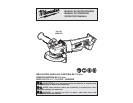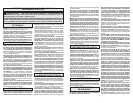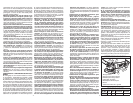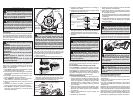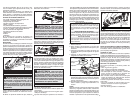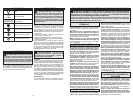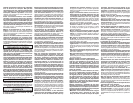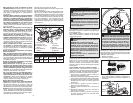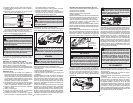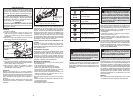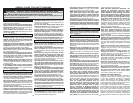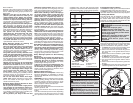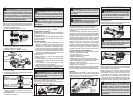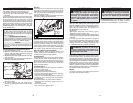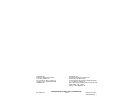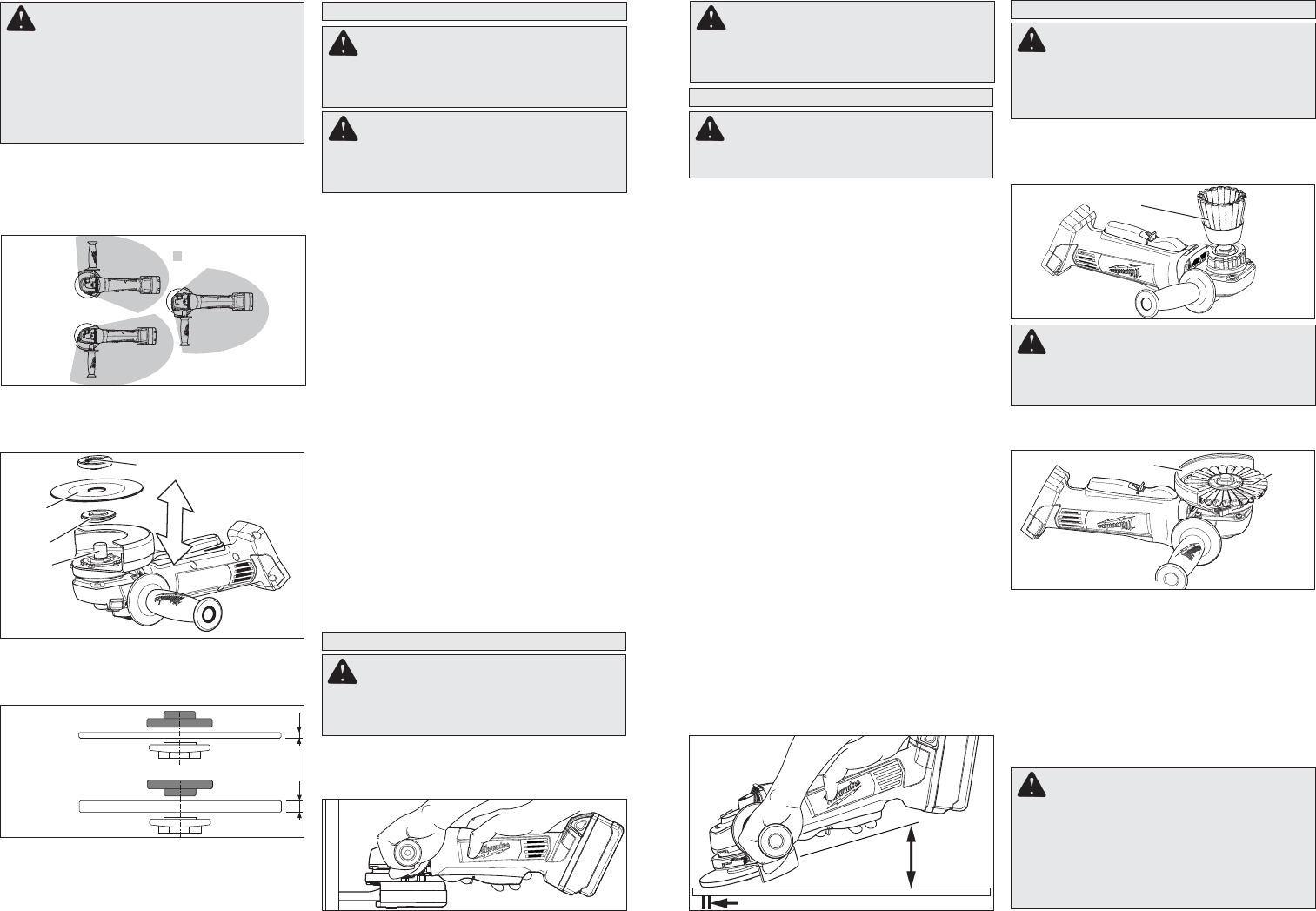
24
25
OPERATION
WARNING To reduce the risk of in-
jury, keep hands away from all moving parts.
Always wear safety goggles or glasses with
side shields.
WARNING Always remove battery
pack before changing or removing accesso-
ries. Only use accessories specifi cally recom-
mended for this tool. Others may be hazardous.
WARNING Only use accessories with
Maximum Safe Operating Speed rated at least
equal to the maximum speed marked on the
power tool. This speed is based on the strength
of the wheel, allowing for a reasonable mea-
sure of safety. It is not meant to imply a best or
most effi cient operating speed. Do not exceed
the Maximum Safe Operating Speed.
Installing/Removing Accessories
Make sure the wheel does not extend beyond the
bottom of the guard. Threaded hub grinding wheels
may require a deeper guard (see "Accessories").
1. Remove the battery pack.
2. Properly position the guard (Fig. 2).
5. Place the selected wheel on the spindle and align
it with the fl ange.
6. Position the fl ange nut over the spindle according
to wheel thickness (Fig. 4).
7. Press in the spindle lock button while turning the
fl ange nut clockwise. Tighten securely using a
spanner wrench.
8. To remove wheel, remove the battery pack and
reverse the procedure.
Flange nut
position for
1/8" thick or less wheels
Fig. 4
1/8"
1/4"
Flange nut
position for
1/4" thick or more wheels
Fig. 2
Operator's Zones
Spindle
Flange
Wheel
Flange nut
Fig. 3
3. Wipe the flange, flange nut and spindle to
remove dust and debris. Inspect the parts for
damage. Replace if needed.
4. Place the fl ange on spindle, as shown.
Controlled Start
The controlled start feature reduces the torque
reaction "jerk" when its trigger is pulled.
Paddle Switch Operation
To start the tool, grasp the handle and side handle
fi rmly. Pull the lock-off button back and squeeze
the paddle switch.
To stop the tool, release the paddle switch. Make
sure the tool comes to a complete stop before lay-
ing the tool down.
General Operation
1. If you have just installed an accessory or are
beginning a period of work, test it by letting it
spin for one minute before applying it to the
workpiece. Out-of-balance or damaged acces-
sories can mar workpiece, damage the tool, and
cause stress that may cause accessory failure.
2. Use a clamp, vise or other practical means to hold
your work, freeing both hands to control the tool.
3. Hold tool securely with both hands.
4. Start the tool.
5. Allow accessory to come to full speed before
beginning work.
6. Control pressure and surface contact between
accessory and workpiece. Too much pressure
slows speed.
If the tool stalls, release the trigger to reset.
Lighten pressure to avoid stalling.
7. When fi nished, turn off the tool and make sure it
comes to a complete stop before laying it down.
Fig. 6
WARNING A Type "1" guard must be
installed when using a cut-off wheel to provide
maximum protection for the operator if the
wheel should break.
USING CUT-OFF WHEELS
Type "1" Cut-Off Wheels are suited for small cut-off
and shallow notching operations only.
When using a cut-off wheel, hold the tool as shown,
using only the edge of the wheel.
WARNING Using the face of a Cut-Off
Wheel (as in grinding) will cause the Wheel
to crack and break, resulting in serious per-
sonal injury.
WARNING To reduce the risk of injury,
the operator should be instructed in the use,
care and protection of grinding wheels.
Fig. 5
For best result use only this portion of disc
Hold at a
Hold at a
5° to 15°
5° to 15°
angle
angle
USING GRINDING WHEELS
Grinding Wheel Selection
Use grinding wheels, and accessories that are:
• correct size as written on tool’s nameplate.
• rated at or above the RPM listed on the tool’s
nameplate.
• correct accessory, wheel type and grit for the job.
Grinding is the cutting action of thousands of abra-
sive grains on the face of a grinding wheel. When
grinding metals such as steel and iron, choose an
aluminum oxide grinding wheel. Select a silicon
carbide grinding wheel for stone and concrete. Use
cotton reinforced wheels for non-ferrous metals.
Type 27 Reinforced 1/8" thick or less Cut-Off
Wheels are suited for small cut-off and shallow
notching operations only. Always handle wheels
carefully to avoid damage. Before installing any
wheel, always inspect it for cracks. If wheel is
cracked, discard it to prevent others from using it.
Care of Grinding & Cut-Off Wheels
Grinding/cut-off wheels should be protected from:
• wetness and extreme humidity
• any type of solvent
• extreme changes in temperature
• dropping and bumping
Grinding and cut-off wheels should be stored:
• in an organized way so wheels can be removed
without disturbing or damaging other wheels
• with their safety information
Grinding and cut-off wheels should NOT be
dropped, rolled or bumped.
Discard wheels that have been dropped, rolled,
bumped, subjected to extreme changes in tempera-
ture, or come into contact with solvents or wetness.
Grinding
When grinding, hold tool at a 5
o
to 15
o
angle, using
constant pressure for a uniform fi nish. Too great an
angle causes concentrated pressure on small areas
which may gouge or burn work surface.
Fig. 7
Wire Cup Brush
Wire
Wheel
Brush
Fig. 8
Guard
WARNING Everyone in the area must
wear protective clothing and safety goggles
or face shields. Fatigued wires and residue
will fl y off the brush with considerable force,
causing potential for serious injury.
WARNING Never exceed Maximum
Safe Operating Speed of brush. Do not use
a damaged brush or one that is functioning
improperly (throwing wires, out-of-balance,
etc.). These conditions increase the pos-
sibility of further brush failure and possible
injury. Discard and replace damaged brushes
immediately.
USING WIRE BRUSHES
Wire brushes are useful for removing rust, scale,
burrs, weld slag, etc.
Always install wire cup brushes according to the
accessory manufacterer’s instructions.
Test wheel for balance and loose or damaged wires
by letting it spin for one minute before applying it
to the workpiece. During this time, no one should
stand in front of or in line with it.
Control pressure and surface contact between
wheel and workpiece. Too much pressure causes
over-bending of wires and heat build-up caus-
ing premature wire breaking, rapid dulling and
reduced brush life. Instead of more pressure, try
a wire wheel with more aggressive cutting action
(increased wire size, decreased wire length or dif-
ferent brush type (knot type vs.crimped wire type).
When using a wire wheel brush, install guard ac-
cording to "Installing/Removing Accessories".
WARNING Because the wires on wire
wheel brushes are directed towards the op-
erator, a guard must be used to protect the
operator when fatigued wires break.



